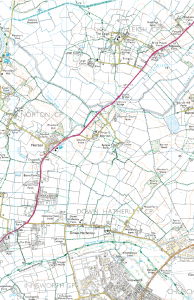First, do no harm…
Kennel-watching: a useful tactic when you don’t have any meets for hunts in the area and know that a particular hunt should be out on a certain day – we go to the kennels early on and wait for the hunt to leave, following them to the meet.
Meet Card: it would be fantastic to have some of these because it would save a ot of kennel-watching. They are a fixture list of where and when the hunt will be meeting throughout the season. The only hunt still advertising their meets (up until the 2019 – 2020 season) was the Duke of Beaufort’s Hunt (who are monitored by the fantastic Cirencester Illegal Hunt Watch). Let us know if you’ve got any meets or, indeed, a meet card past or present for any hunt!
Hunting Horns: horns are used by the hunt to control the hounds – to encourage or call back – or to signify the end of the day, a kill or to summon the terriermen. Sabs can also use them to try and get the hounds to stop them giving chase to the hunted animal, to bring the pack over or lift the heads of the hounds, taking their noses off the scent and giving the hunted animal a few more valuable seconds to escape.
Citronella Sprays: we tend to use a mix of a few drops of citronella essential oil (the stuff horse riders often use to repel flies from the horses) and water in a spray bottle, like the kind used in the garden. This is used to cover the scent left by a fox. So if we saw a fox running from a hedgerow into a woodland and hounds were nearby or hunting the fox, we would spray in a wide area around where the fox had run, foiling the scent, even temporarily.
Whips: whips are used by the hunt (in particular, the whippers-in) to control the hounds. A whip is like an “off-switch” for the hounds; they are used to stop the hounds if they are rioting on an animal they’re not supposed to be hunting or are going too near to main roads, motorways or railways. Sabs can also use whips to try and stop the hounds giving chase to the hunted animal or going on to roads, etc.
Gizmo: a relatively new tool in sabbing for many groups, the ‘gizmo’ consists of something like an MP3 with ‘hounds in cry’ recorded on to it (or horn calls) and a speaker. You can play it when you want to bring the pack of hounds to you or to lift their heads, but it isn’t guaranteed to work, especially not if you try and do it several times in a day! The hounds know who the leader of their pack is and you can’t keep fooling them by playing the sound of other hounds speaking to them – they will realise there’s nothing to chase when they get to you!
Radios: very useful in order to communicate between groups, individual sabs and vehicles – much easier than having to get your phone out of your pocket repeatedly.
Voice Calls and Rating: used by the hunt and sabs alike to try and control the hounds. We ‘rate’ the hounds with shouts like “leave it” and “get back to him” to tell them off if they are hunting an animal or getting too near to a road or railway. Holloas (high-pitched yells) may also be used to try and lift the heads of the hounds, distracting them for a few valuable seconds.
Cameras: can be a fantastic sabbing-tactic as some hunts will call hounds off a scent if they believe you have the hunted animal on camera (this will only work while hunting remains a legal grey-area). They will also be useful if you want to gather evidence of other illegal activity or have proof of what you or the hunt / support have been up to all day.
Baling twine: a useful thing to have with you in case gates won’t shut properly, you find a loose hound and for various other emergencies! Wire cutters have come in handy a couple of times when horses or hounds have become tangled in wire, as have first aid kits.
Maps: always a useful tool. Many of us know the local areas and hunt country pretty well, but it can always be good to look at a map, find a little-known-about footpath or, of course, tell others where you are!
Extremely important things to remember while out include making sure you do not scare a fox / hare / other animal out of their hiding places or into the hounds, not calling the hounds towards you if there’s a road or railway in between or behind you and not calling them over if you can’t see the pack or if there’s an area in between you and the pack that an animal could be hiding up from the hunt



